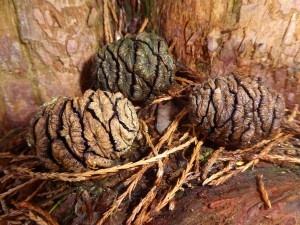
Cones make a beautiful addition to Christmas wreathes and decorations but often go unnoticed, hanging high in trees, out of reach until they fall to the ground. Commonly called pine cones, there are in fact many kinds of cones that grow on different cone bearing trees called conifers. A short walk along the Tall Trees Trail in the New Forest is a wonderful way to experience and learn about some very spectacular conifer trees and their unique cone designs. Read on to begin your cone hunt challenge.
Start at Blackwater car park in the picnic area directly opposite the main information panel. Here look for tiny oval shaped cones, the size of adult’s thumb nail, that have fallen onto the ground from the trees above. These are western hemlock cones. Cones take their name from the parent tree.
Look closely at the overlapping rounded leaf-like scales which hold and protect the trees seeds – they look like miniature rose flowers. When fully grown the scales of cones open to release the hidden seeds inside before eventually falling to the ground.
Now head to the start of the Tall Trees Trail – across the road towards the arboretum. Look for fallen cones approx. the length of your finger (5-7.5 cm) which have fallen around the base of the huge conifer trees with distinctive thick corky bark. These are Douglas fir cones and they have a unique scale pattern where the three-pronged seeds (bracts) can be seen poking out under the scales – they look just like the tail and two back legs of tiny mice.
Douglas fir is the most common tree along the trail and grows to be one of the tallest trees in Britain. They create an impressive avenue of giants – go on give one a hug! It takes about 4 adult hugs (or 8 small person hugs) to reach around these giants.
Fir cone challenge: Find a scale from a cone that’s been eaten by a hungry squirrel. Look up to spot cones hanging upside down from a branch. Can you see any cones with sap?
Next spot the coast redwood: an impressively tall tree with soft fibrous red bark. These trees can grow to become the tallest living things on earth. Surprisingly it has very small cones for such a huge giant! Look for its fallen round shaped cones, the size of a hazelnut, often still attached to the tip of a twig shoot.

Continue along the trail to the two enormous wellingtonia on your left, better known as giant sequoias. These are the largest trees in the New Forest, yet the seeds within their cones are as small as a grain of rice. Look on the ground for their plum-sized round hard cones which look like small grenades.
Top fact: Wellingtonia can live up to 3,400 years and are some of the oldest known living trees.
As you approach the top section of the trail, just before Brock Hill car park, look for fallen Norway spruce cones on your right. These are long cylinder shaped cones with smooth rounded scales which feel just like snake skin. Do the young tree seedlings growing in the space between these trees look familiar? That’s because our traditional Christmas trees are Norway spruce.
Now cross the road and continue following the trail along the opposite side back to the start. Bonus cone spot: Scots pine cone. Look for a conifer tree with distinctive orangery red bark towards the top of its trunk. Its familiar shaped cones are used for decorations and when dry its woody scales open up; shake the cone to see its seeds spin to the ground.
I hope these activities open your eyes to the wonder of cones and leave you pining for more.
The Tall Trees Trail is 1.5 miles, easy access along a level gravel track.
